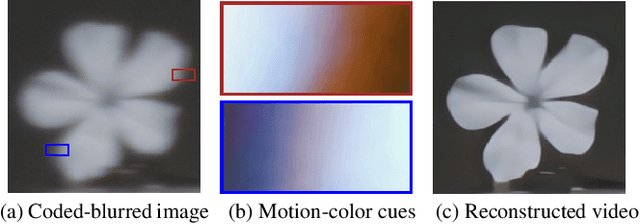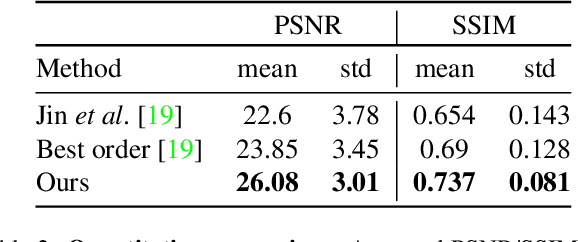Erez Yosef
DifuzCam: Replacing Camera Lens with a Mask and a Diffusion Model
Aug 14, 2024Abstract:The flat lensless camera design reduces the camera size and weight significantly. In this design, the camera lens is replaced by another optical element that interferes with the incoming light. The image is recovered from the raw sensor measurements using a reconstruction algorithm. Yet, the quality of the reconstructed images is not satisfactory. To mitigate this, we propose utilizing a pre-trained diffusion model with a control network and a learned separable transformation for reconstruction. This allows us to build a prototype flat camera with high-quality imaging, presenting state-of-the-art results in both terms of quality and perceptuality. We demonstrate its ability to leverage also textual descriptions of the captured scene to further enhance reconstruction. Our reconstruction method which leverages the strong capabilities of a pre-trained diffusion model can be used in other imaging systems for improved reconstruction results.
Tell Me What You See: Text-Guided Real-World Image Denoising
Dec 15, 2023Abstract:Image reconstruction in low-light conditions is a challenging problem. Many solutions have been proposed for it, where the main approach is trying to learn a good prior of natural images along with modeling the true statistics of the noise in the scene. In the presence of very low lighting conditions, such approaches are usually not enough, and additional information is required, e.g., in the form of using multiple captures. In this work, we suggest as an alternative to add a description of the scene as prior, which can be easily done by the photographer who is capturing the scene. Using a text-conditioned diffusion model, we show that adding image caption information improves significantly the image reconstruction in low-light conditions on both synthetic and real-world images.
Mind The Edge: Refining Depth Edges in Sparsely-Supervised Monocular Depth Estimation
Dec 10, 2022



Abstract:Monocular Depth Estimation (MDE) is a fundamental problem in computer vision with numerous applications. Recently, LIDAR-supervised methods have achieved remarkable per-pixel depth accuracy in outdoor scenes. However, significant errors are typically found in the proximity of depth discontinuities, i.e., depth edges, which often hinder the performance of depth-dependent applications that are sensitive to such inaccuracies, e.g., novel view synthesis and augmented reality. Since direct supervision for the location of depth edges is typically unavailable in sparse LIDAR-based scenes, encouraging the MDE model to produce correct depth edges is not straightforward. In this work we propose to learn to detect the location of depth edges from densely-supervised synthetic data, and use it to generate supervision for the depth edges in the MDE training. %Despite the 'domain gap' between synthetic and real data, we show that depth edges that are estimated directly are significantly more accurate than the ones that emerge indirectly from the MDE training. To quantitatively evaluate our approach, and due to the lack of depth edges ground truth in LIDAR-based scenes, we manually annotated subsets of the KITTI and the DDAD datasets with depth edges ground truth. We demonstrate significant gains in the accuracy of the depth edges with comparable per-pixel depth accuracy on several challenging datasets.
Video Reconstruction from a Single Motion Blurred Image using Learned Dynamic Phase Coding
Dec 28, 2021



Abstract:Video reconstruction from a single motion-blurred image is a challenging problem, which can enhance existing cameras' capabilities. Recently, several works addressed this task using conventional imaging and deep learning. Yet, such purely-digital methods are inherently limited, due to direction ambiguity and noise sensitivity. Some works proposed to address these limitations using non-conventional image sensors, however, such sensors are extremely rare and expensive. To circumvent these limitations with simpler means, we propose a hybrid optical-digital method for video reconstruction that requires only simple modifications to existing optical systems. We use a learned dynamic phase-coding in the lens aperture during the image acquisition to encode the motion trajectories, which serve as prior information for the video reconstruction process. The proposed computational camera generates a sharp frame burst of the scene at various frame rates from a single coded motion-blurred image, using an image-to-video convolutional neural network. We present advantages and improved performance compared to existing methods, using both simulations and a real-world camera prototype.
 Add to Chrome
Add to Chrome Add to Firefox
Add to Firefox Add to Edge
Add to Edge